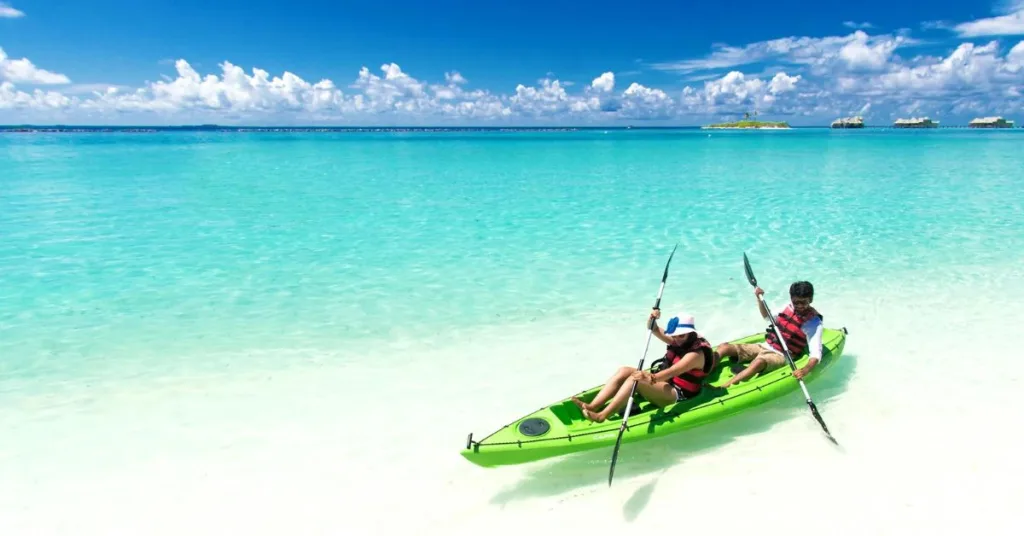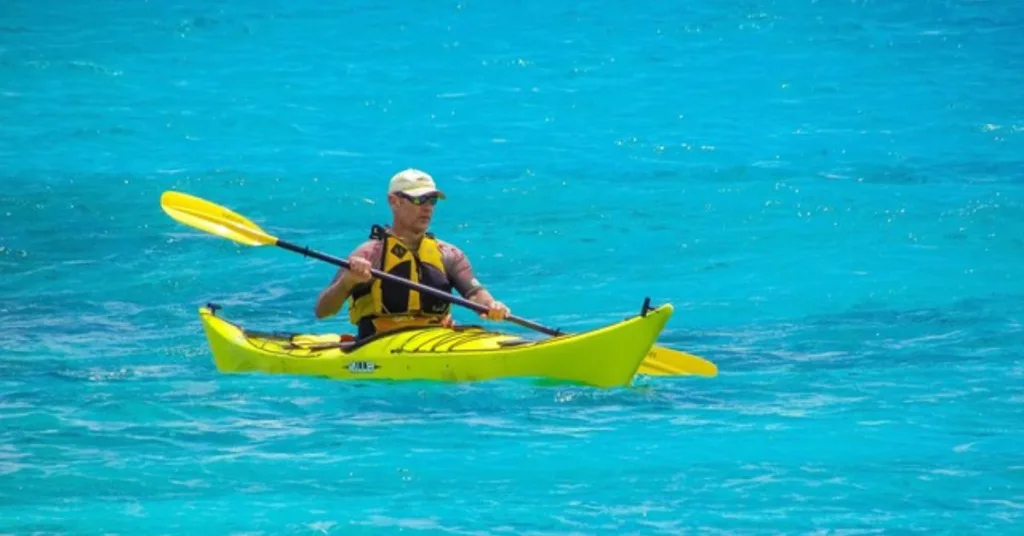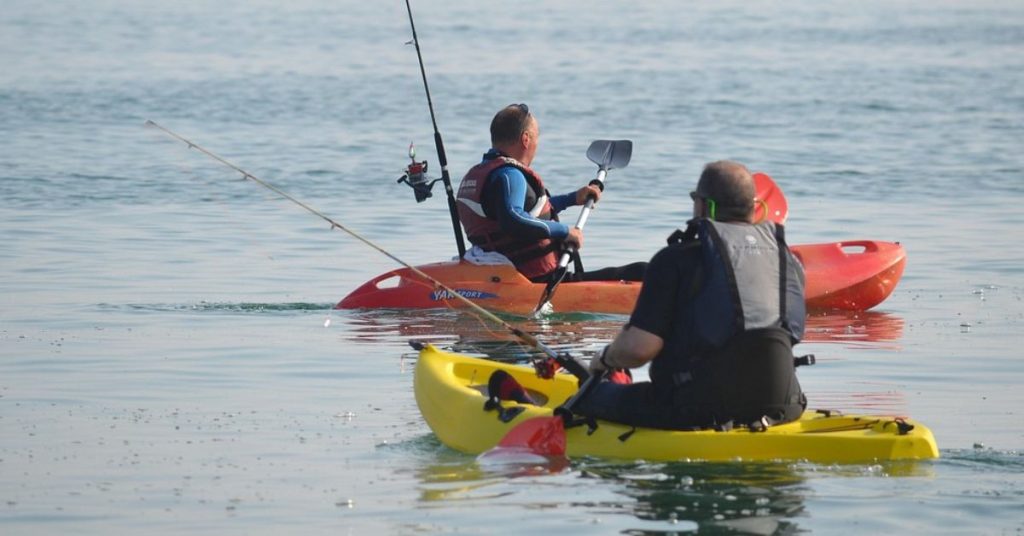Kayaking offers a unique way to explore the beauty of our waters. While many people enjoy paddling on serene lakes and gentle rivers, the ocean presents a whole new world to explore. But, can you kayak in the ocean? The short answer is yes, you can. However, kayaking in the ocean comes with its own set of challenges and considerations. In this article, we’ll explore what it takes to safely and enjoyably kayak in the ocean, including the types of kayaks best suited for the sea, safety tips, and the thrilling experience of kayak fishing.

Understanding Ocean Kayaking
Ocean kayaking, also known as sea kayaking, differs significantly from river or lake kayaking. The ocean’s vastness, powerful waves, and unpredictable weather conditions require specialized skills and equipment. Let’s delve into what makes ocean kayaking unique and how you can prepare for it.
Characteristics of Ocean Kayaks
When considering ocean kayaking, choosing the right type of kayak is crucial. Sea kayaks are specifically designed for ocean conditions. They are typically longer and narrower than recreational kayaks, offering better stability and speed in open waters.
Length and Shape: Sea kayaks usually range from 12 to 18 feet in length. The longer shape helps in cutting through waves and maintaining a straight course. A streamlined design reduces drag, allowing for efficient paddling even in choppy seas.
Stability and Speed: A narrower width provides less resistance, allowing for more speed. However, this can make the kayak feel less stable to beginners. It’s important to find a balance between speed and stability to match your skill level and the conditions you’ll face.
Storage Compartments: Sea kayaks often include sealed compartments for storing gear, keeping it dry and secure even in choppy waters. These compartments are crucial for long trips, enabling you to carry essential supplies like food, water, and safety gear.
Rudder or Skeg: These features help in steering and maintaining direction, especially in windy conditions. A rudder or skeg can significantly improve control, particularly when paddling in strong currents or crosswinds.
Essential Skills for Ocean Kayaking
Kayaking in the ocean demands a certain level of expertise. Unlike calm lakes, the ocean presents dynamic and challenging conditions that require preparation and practice.
Paddling Techniques: Mastering efficient paddling techniques can make a significant difference in your kayaking experience. Practice forward strokes, sweep strokes, and the all-important brace strokes to handle unexpected waves.
Navigational Skills: The vastness of the ocean can be disorienting. Learning how to use a compass, read nautical charts, and understand GPS devices will help you navigate safely.
Self-Rescue Techniques: Knowing how to re-enter your kayak from the water and perform a wet exit is crucial. These skills can help you recover from capsizing and ensure your safety in open waters.
Weather and Sea Condition Assessment: Understanding how to assess weather and sea conditions is vital for ocean kayaking. Develop the ability to read weather patterns and recognize signs of changing conditions to make informed decisions about when to paddle.
Equipment Considerations for Ocean Kayaking
Selecting the right equipment is essential for a successful ocean kayaking adventure. The ocean environment demands gear that can withstand challenging conditions and keep you safe.
Kayak Materials and Construction: Choose kayaks made from durable materials like fiberglass or polyethylene, which can endure rough seas and rocky shorelines. Lightweight materials are also advantageous for transportation and maneuverability.
Paddles: Invest in high-quality paddles that are lightweight yet sturdy. Consider adjustable paddles to accommodate different paddling styles and conditions.
Safety Gear: Beyond a life jacket, equip yourself with a whistle, a signal mirror, a VHF radio, and a first aid kit. These tools are essential for communication and safety in emergencies.
Clothing and Accessories: Dress for the water temperature, not just the air. Wear a wetsuit or drysuit to stay warm in cold waters, and don’t forget sun protection, including a hat and sunscreen.
Safety Tips for Ocean Kayaking
Safety should always be a priority when venturing into the ocean. Here are some essential safety tips to ensure a safe kayaking experience:

Check Weather and Tides
Before heading out, always check the weather forecast and tide schedules. Sudden weather changes can turn a pleasant outing into a dangerous situation. Understanding tide patterns can also help in planning your trip.
Weather Monitoring: Utilize weather apps and marine forecasts to stay informed about conditions. Pay attention to wind speeds, swell heights, and potential storms that could affect your journey.
Tide Awareness: Study tide charts and understand how tides influence your route. Plan your trip to coincide with favorable tidal conditions, and be prepared for potential changes.
Emergency Plans: Have a contingency plan in place for unexpected weather changes. Know where safe landing spots are located along your route.
Wear a Life Jacket
A personal flotation device (PFD) is non-negotiable. Always wear a life jacket designed for kayaking, as it provides buoyancy and does not restrict movement.
Proper Fit: Ensure your life jacket fits snugly and is suitable for your weight and size. A well-fitted PFD enhances comfort and safety.
Regular Maintenance: Inspect your life jacket regularly for signs of wear and tear. Replace it if it shows any damage to ensure it functions correctly.
Accessibility: Keep your PFD easily accessible at all times. In an emergency, you may not have time to search for it.
Learn Basic Skills
Familiarize yourself with essential kayaking skills, such as paddling techniques, re-entering a kayak from the water, and performing a wet exit. Practicing these skills in calm waters before heading to the ocean can build confidence and readiness.
Skill Development: Take kayaking courses or join clubs to improve your skills. Experienced instructors can provide valuable guidance and feedback.
Practice Drills: Regularly practice self-rescue drills with your paddling group. Simulating real-life scenarios helps you respond effectively in emergencies.
Continuous Learning: Stay updated on the latest kayaking techniques and safety practices through online resources and workshops.
Go with a Group
Kayaking with a group or a partner is not only more enjoyable but also safer. In case of an emergency, having others around can make a significant difference.
Group Dynamics: Establish clear communication and roles within your group. Assign responsibilities for navigation, safety checks, and emergency response.
Buddy System: Pair up with a kayaking partner for mutual support. Keep an eye on each other and maintain visual contact throughout the trip.
Communication Devices: Equip your group with waterproof communication devices, such as radios or phones, for reliable contact in remote areas.
The Experience of Kayak Fishing
One of the exciting activities you can try while ocean kayaking is kayak fishing. Combining the thrill of kayaking with the challenge of fishing in the open sea is an experience like no other.
Why Kayak Fishing?
Kayak fishing offers a more intimate connection with the water. It allows you to access fishing spots that are often unreachable by larger boats, and it’s environmentally friendly. The stealth of a kayak can also bring you closer to fish without scaring them away.
Access to Remote Locations: Kayaks can navigate shallow waters and narrow channels, giving you access to untouched fishing spots teeming with fish.
Environmental Impact: Kayak fishing has a minimal environmental footprint, as it relies on human power rather than fuel-driven engines. This eco-friendly approach promotes sustainable fishing practices.
Stealth and Approach: The quiet nature of a kayak allows you to approach fish silently, increasing your chances of a successful catch. This stealthy approach is especially advantageous for catching elusive species.
Equipment for Kayak Fishing
To fully enjoy kayak fishing, you’ll need the right equipment tailored to your needs.
Fishing Kayak: While you can use a sea kayak for fishing, specialized fishing kayaks come with additional features like rod holders and extra storage. Consider a kayak with a stable platform for standing and casting.
Fishing Gear: Bring along your fishing rods, tackle, and bait. Ensure your gear is securely attached to avoid losing it overboard. Invest in waterproof bags to protect your equipment from saltwater exposure.
Safety Gear: In addition to your PFD, a whistle, mirror, and VHF radio can be invaluable for communication and signaling in emergencies. Carry a knife and a first aid kit for added preparedness.
Tips for Kayak Fishing

Anchor System: An anchor can help keep your kayak stable while you fish. Make sure it’s easy to deploy and retrieve. Choose an anchor suitable for the seabed type in your fishing area.
Stay Organized: Keep your tackle and gear organized for easy access. Use waterproof containers or bags to protect your belongings. Label compartments for quick identification of essential items.
Be Patient and Respectful: Ocean fishing can require patience. Respect other kayakers and anglers, and share the waters responsibly. Follow local fishing regulations and practice catch-and-release when necessary.
Timing and Tides: Plan your fishing trips around tidal movements and feeding times for the best chances of success. Research local fish behavior to optimize your efforts.
Benefits of Ocean Kayaking
Ocean kayaking offers numerous benefits beyond the thrill of adventure. It provides a great workout, improves mental health, and deepens your appreciation for nature.
Physical Fitness
Paddling through the ocean waters gives your upper body, core, and legs a fantastic workout. It improves cardiovascular health, builds muscle strength, and enhances endurance.
Full-Body Exercise: Ocean kayaking engages multiple muscle groups, including your arms, shoulders, back, and core. This full-body workout improves overall fitness.
Cardiovascular Benefits: The sustained effort required for paddling increases heart rate, promoting cardiovascular health and endurance over time.
Flexibility and Balance: The dynamic nature of ocean kayaking enhances flexibility and balance, as you adapt to changing conditions and maintain stability on the water.
Mental Health
Being out on the water, surrounded by the endless horizon, can be incredibly calming and meditative. Ocean kayaking allows you to disconnect from the stresses of daily life and reconnect with nature.
Stress Reduction: The rhythmic motion of paddling and the soothing sounds of the ocean can significantly reduce stress and anxiety levels.
Mindfulness and Presence: Kayaking encourages mindfulness, as you focus on the present moment and immerse yourself in the natural environment.
Boosted Mood: The combination of physical activity, fresh air, and stunning scenery can elevate mood and improve overall mental well-being.
Environmental Awareness
Kayaking fosters a greater understanding and appreciation of marine ecosystems. Witnessing wildlife in their natural habitat encourages conservation efforts and respect for the environment.
Close Encounters with Wildlife: Ocean kayaking provides opportunities to observe marine life up close, from dolphins and seals to seabirds and colorful fish.
Conservation Mindset: Experiencing the beauty and fragility of marine ecosystems firsthand fosters a conservation mindset and a desire to protect these environments.
Educational Opportunities: Kayaking can serve as an educational tool, teaching participants about marine biodiversity, ecosystems, and the importance of sustainable practices.
Conclusion
So, can you kayak in the ocean? Absolutely. With the right equipment, skills, and safety precautions, ocean kayaking can be a rewarding experience filled with adventure and discovery. Whether you’re navigating through waves, exploring hidden coves, or enjoying a day of kayak fishing, the ocean offers endless possibilities for exploration. Embrace the challenge and dive into the exhilarating world of ocean kayaking. Prepare thoroughly, respect the ocean, and embark on a journey that connects you with nature in its most raw and beautiful form.
Also Read
